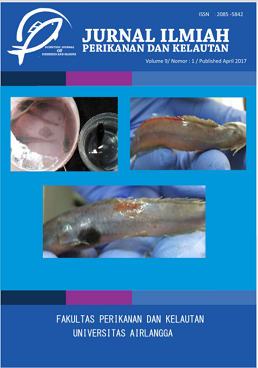Date Log
1. Copyright of the article is transferred to the journal, by the knowledge of the author, whilst the moral right of the publication belongs to the author.
2. The legal formal aspect of journal publication accessibility refers to Creative Commons Atribusi-Non Commercial-Share alike (CC BY-NC-SA), (https://creativecommons.org/licenses/by-nc-sa/4.0/)
3. The articles published in the journal are open access and can be used for non-commercial purposes. Other than the aims mentioned above, the editorial board is not responsible for copyright violation
The manuscript authentic and copyright statement submission can be downloaded ON THIS FORM.
Peningkatan Nilai Nutrisi Pollard melalui Fermentasi Ragi Tempe sebagai Bahan Pakan Buatan Ikan Nila (Oreochromis niloticus)
[ Increased Nutritional Value Pollard Through Yeast Fermentation Tempe as Artificial Feed Ingredients Tilapia (Oreochromis niloticus)]
Corresponding Author(s) : Gunanti Mahasri
Jurnal Ilmiah Perikanan dan Kelautan,
Vol. 7 No. 1 (2015): JURNAL ILMIAH PERIKANAN DAN KELAUTAN
Abstract
Abstract
Tilapia (Oreochromis niloticus) is a type of fish that is easily cultivated in various places (pond, floating cage and rice fields). Pollard is an alternative feed ingredients that have great potential, both as a source of energy, crude fiber source, or sources other macro nutrients. Mold in fermentation used and contributes to a feed enzymes that help digestion and to penetrate into the network feed that network structure becomes brittle and breaks down and the surface becomes more widespread. more surface enables direct contact with digestive enzymes cellulose greater. The results of the analysis of the nutrient content of food research trials show that using tempeh fermentation pollard 0.2% can increase the nutritional value of protein pollard 14.88%. Pollard tempeh fermentation using 0.2% can improve the digestibility of crude fiber and digestibility of dry matter pollard. Feed consumption of tilapia in the treatment using fermented tempeh pollard 0.2% is not significantly different from the commercial feed. Pollard tempeh fermentation using 0.2% to 16.98% protein content can increase the growth rate of tilapia.
Keywords
Download Citation
Endnote/Zotero/Mendeley (RIS)BibTeX
- Gultom D., Yono C, H dan Haryati, T. 2000. Evaluasi Nilai Nutrisi Pollard Gandum Terfermentasi dengan Aspergillus niger NRRL 337 pada Itik Alabio dan Mojosari. Seminar Nasional Peternakan dan Veteriner 2000.
- Halver JE. 1988. Fish Nutrition. Academis Press, INC. London, 798 pp.
- Iskandar,Y. M., 2002, Isoflavonoida Hasil Fermentasi Kedelai Menggunakan Inokulum Kultur Campuran, Prosiding Semnas XI, Jasakiai, Yogyakarta.
- Jennessen, J., J. Schnurer, J. Olsson, R.A.Samso n, and J. Dijksterhuis, 2008, Morphological characteristics of sporangiospores of the tempefungus Rhizopus oligosporus differentiate it fromother taxa of the R. microsporu s group. Mycol. Res, Vol. 112, 54763.
- Lovell, T. 1989. Nutrition and feeding of fish. Van Nostrand Reinhold, New York, p. 26-45. Mardiastuti., 2004. Pengaruh Penggunaan Dedak Gandum (Wheat pollard) terfermentasi Terhadap Kualitas Telur Ayam Arab. Skripsi Fakultas Pertanian Universitas Sebelas Maret, Surakarta.
- National Freshwater Fisheries Tecnology Center. 2006. Basic Biology of Tilapia. NFFTC Aqua-Leafleat.
- Nueva Ecija. 2000-06. Prasetyawan JI. 2009. Penggunaan Wheat Pollard fermentasi dalam konsentrat terhadap performan kelinci keturunan Vlaamse Reus Jantan. Skripsi. Fakultas Pertanian Universitas Sebelas Maret Surakarta.
- Siri , S., H. Tobioka and I. Tasaki. l992. Effects of Dietary Cellulose Level on NutrientUtilization in Chickens. AJAS 5 (4) : 741 - 746.
- Wahyuni, E. T., 2004. Pengaruh Penggunaan Wheat pollard (Dedak Gandum)Terfermentasi terhadap Performan Produksi Ayam Arab. Skripsi FakultasPertanian Universitas Sebelas Maret, Surakarta.
- Wardoyo, S. E. 2007. Ternyata Ikan Nila, Oreochromis niloticus Mempunyai Potensi yang Besar untuk Dikembangkan. Media Akuakultur, 2: 147-150.
References
Gultom D., Yono C, H dan Haryati, T. 2000. Evaluasi Nilai Nutrisi Pollard Gandum Terfermentasi dengan Aspergillus niger NRRL 337 pada Itik Alabio dan Mojosari. Seminar Nasional Peternakan dan Veteriner 2000.
Halver JE. 1988. Fish Nutrition. Academis Press, INC. London, 798 pp.
Iskandar,Y. M., 2002, Isoflavonoida Hasil Fermentasi Kedelai Menggunakan Inokulum Kultur Campuran, Prosiding Semnas XI, Jasakiai, Yogyakarta.
Jennessen, J., J. Schnurer, J. Olsson, R.A.Samso n, and J. Dijksterhuis, 2008, Morphological characteristics of sporangiospores of the tempefungus Rhizopus oligosporus differentiate it fromother taxa of the R. microsporu s group. Mycol. Res, Vol. 112, 54763.
Lovell, T. 1989. Nutrition and feeding of fish. Van Nostrand Reinhold, New York, p. 26-45. Mardiastuti., 2004. Pengaruh Penggunaan Dedak Gandum (Wheat pollard) terfermentasi Terhadap Kualitas Telur Ayam Arab. Skripsi Fakultas Pertanian Universitas Sebelas Maret, Surakarta.
National Freshwater Fisheries Tecnology Center. 2006. Basic Biology of Tilapia. NFFTC Aqua-Leafleat.
Nueva Ecija. 2000-06. Prasetyawan JI. 2009. Penggunaan Wheat Pollard fermentasi dalam konsentrat terhadap performan kelinci keturunan Vlaamse Reus Jantan. Skripsi. Fakultas Pertanian Universitas Sebelas Maret Surakarta.
Siri , S., H. Tobioka and I. Tasaki. l992. Effects of Dietary Cellulose Level on NutrientUtilization in Chickens. AJAS 5 (4) : 741 - 746.
Wahyuni, E. T., 2004. Pengaruh Penggunaan Wheat pollard (Dedak Gandum)Terfermentasi terhadap Performan Produksi Ayam Arab. Skripsi FakultasPertanian Universitas Sebelas Maret, Surakarta.
Wardoyo, S. E. 2007. Ternyata Ikan Nila, Oreochromis niloticus Mempunyai Potensi yang Besar untuk Dikembangkan. Media Akuakultur, 2: 147-150.
